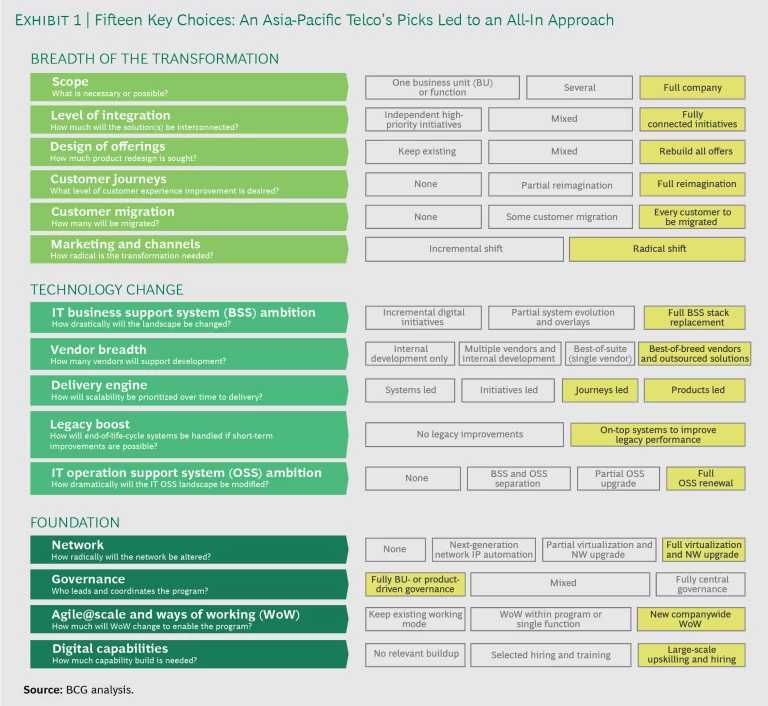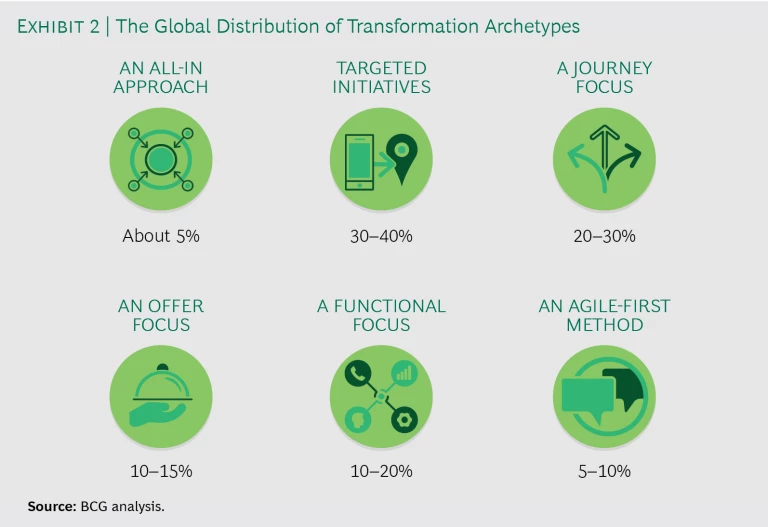Many telecommunications companies are working to transform themselves in order to operate and deliver value in new digital ways, but they often pursue these activities in a haphazard fashion. They rarely have a comprehensive digital transformation strategy to guide their initiatives, so they end up making decisions that have huge technical and strategic implications without even realizing they are doing so.
Telcos need to plan their digital transformation pathways much more methodically in order to unlock value and maximize their limited resources. Some might choose a series of incremental changes, while others might opt for a radical path. Either way, companies need to map their journey by going through a rigorous decision-making process—we have pinpointed 15 choices that telcos must make—to streamline operations and open up new opportunities. The 15 choices will help a telco define its transformation archetype and the principles that will characterize its transformation. We have identified six such archetypes.
Making these choices and understanding a company’s archetype can yield significant economic benefits. We estimate that a digital transformation could improve EBITDA and customer satisfaction by up to 30% and employee satisfaction by more than 50%. At the same time, it could reduce operational waste by as much as 50%.
Scarce Resources to Manage Market Disruption
Certain critical market forces in the telecom industry have accelerated in the past several years. We have seen new players disrupting entire markets—for example, Iliad with its low-price propositions first in France and now in Italy, MásMóvil in Spain, and Reliance Jio Infocomm in India. Meanwhile, existing players have been changing their go-to-market strategy, as T-Mobile US did in positioning itself as the “un-carrier” against its competition. Further market consolidation has also been taking place: Telenor is acquiring the Finnish telecom operator DNA in Finland, Vodafone is trying to buy Unitymedia in Germany after Telefónica purchased KPN subsidiary E-Plus, and Sprint US is attempting to merge with T-Mobile US. And new players, such as United Internet in Germany, are now gaining access to 5G frequencies.
Not all telecom markets are undergoing such dramatic disruption, but even in markets that have less competition and where conditions are (for the moment) relatively stable, companies must choose their transformational pathway carefully to avoid falling behind local competitors or creating an opening for new players to enter the market.
Given the major resource constraints that most telecom providers face, both financially and in terms of their management capacity, weighing the tradeoffs necessary to bring the digital transformation to life is critical for success. In fact, as market forces accelerate within the telecom industry, winners and losers are already starting to emerge. According to BCG’s Digital Acceleration Index, which measures a company’s degree of digital maturity, the digital leaders in the telecom industry increased their market share lead over the digital laggards by 18% from 2012 through 2017.
As market forces accelerate within the telecom industry, winners and losers are already starting to emerge.
Starting the Journey and Making Choices
Each company’s starting point for its digital transformation is different based on competitive realities, regulatory requirements, the complexity and capability of its technology stack, as well as the quality of its existing network. To identify its starting point, a telecom operator should consider the three building blocks that underlie every telco’s digital transformation:
- The breadth of the transformation across the customer experience and value chain, including products, processes, and end-to-end customer journeys
- The technology, including business support systems (BSS) and operations support systems (OSS)
- The foundational factors that enable the transformation, including institutional ways of working and employees’ capabilities.
As they begin to select the right path going forward, executive teams need to ask themselves some key questions to better understand their company’s starting point:
- What are the competitive pressures?
- What is the downside risk and upside potential to digitizing the business model?
- What are the BSS and OSS complexities and capabilities?
- What is the availability of opex and capex funding for the transformation?
- What is the capacity of management teams in terms of expertise and availability?
- What digital initiatives are under way, and do they offer lessons for designing the transformation journey?
Once the telco understands its starting point across the three building blocks, executives can design the transformation journey. We have pinpointed 15 key choices that telecom leadership teams should make to articulate their strategy and map their journey in pursuit of that strategy. In Exhibit 1, we detail these choices and provide an example of how one company’s choices led it to follow the all-in approach, one of the archetypes of digital transformation that we have identified. (The archetypes are discussed further in the next section.) This methodical approach to designing a digital transformation allows important stakeholders to align on goals, agree on how much they will spend, decide on clear KPIs to measure success, and execute on that vision.
Six Transformation Archetypes
The 15 choices a telco makes will help to define its transformation archetype and the principles that will characterize its transformation. On the basis of our global work with telecom companies, we have identified six digital transformation archetypes. (See Exhibit 2.) Each archetype involves some difficult tradeoffs.
An All-In Approach. The most ambitious of all the archetypes, the all-in approach, requires companies to commit a tremendous amount of resources—in the form of both financial and management capacity—to a holistic program that can manage multiple interdependencies while digitally transforming the entire enterprise. The scope is broad, including a new-product portfolio, novel journeys, a state-of-the-art BSS and OSS stack, and a fundamentally different way of working. This approach to transformation involves substantial complexity and risk, but if managed properly, it can deliver value within five years.
Targeted Initiatives. Instead of pursuing an enterprisewide digital transformation with an IT stack replacement, some telcos are more selective, targeting potential value pools with digital overlays that replace just the existing interfaces. That might mean building a digital solution for a specific process that could yield significant savings or a customer touch point that could yield higher revenue. To accomplish these narrower projects, telecom companies don’t sweep away existing IT systems—instead, they insert the new digital elements on top of or in between the elements of the current IT system landscape. On the one hand, this is a pragmatic approach that focuses on well-defined business requirements and allows for quick test-and-validation cycles that generate value fast. On the other hand, it adds substantial technological complexity that must eventually be resolved.
A Journey Focus. Telcos following this archetype start their transformation with a focus purely on the customer. They begin by reimagining every customer interaction from end to end and designing a completely new customer-centric digital journey. Usually, they aim to move at least 50% of their customers to digital channels. On the basis of these newly revised journeys, they redesign processes and optimize the front end of IT systems. This approach quickly creates tangible solutions for customers and helps reduce waste. But it leaves some original root causes of the poor customer experience untouched—especially on the IT system level, in delivery, and in the product portfolio.
An Offer Focus. Telcos that take this approach focus their digitization journey on a redesign and simplification of their product portfolio, which makes the effort visible to the marketplace very quickly. Especially in the B2B space, telecom companies have thousands of permutations of what they sell and—because they often create bespoke solutions for many if not all customers—they manage huge complexity in their customer base. This archetype is an excellent foundation for a future IT redesign but requires tough decision making on customer migration.
A Functional Focus. Another approach to digital transformation is to sequence the transformation function by function. The company might start with a support unit that is less business critical (such as HR or finance) to gain experience and then proceed to transform more-critical areas of the company one function at a time. This approach is pragmatic, relatively easy to implement, and significantly reduces management complexity. But it ignores process performance across functions, which can hurt overall performance.
An Agile-First Method. Instead of focusing on what to digitize, telcos following this archetype initially focus on how they are going to digitize. These telecom providers look to educate and train employees in order to build their capabilities for digital transformation and empower them to pursue these initiatives. Once these teams have been trained, they usually design a series of pilot projects to test and implement new ways of working. With these results in hand, they then design a broader, more accelerated transformation, although the lead time to financial benefits is usually long.
Some Common Guidelines
Making the right choices and working within the right archetype won’t guarantee success. But some common guidelines can help all telcos set up their digital transformations:
- Consider the capacity constraints of management when choosing the depth and breadth of the transformation. Run projects with a mix of fully dedicated employees and rotating staff from line functions.
- Establish the right balance of power between headquarters and business units (BUs), ensuring that the BUs truly lead and own the programs and initiatives.
- Don’t force two units with very different demands (such as B2B and B2C) to coexist in one stack—the difficulty of aligning the two units far outweighs any potential synergies. Instead, design “breaking points” within the stack to allow for two or more systems when necessary.
- Balance the transformation’s initiatives between quick wins that help build enthusiasm and momentum and longer- term projects that take more time to bear fruit.
- Prepare to invest significant time and money in IT in order to achieve substantial benefits. Overlay architecture is a useful but temporary solution. Eventually, the company will need to devote resources in order to update the stack.
- Apply the same financial discipline to digital projects as you would for any capex project. Don’t approve funding without using rigorous valuation principles and detailed baselining.
- Be open to new technologies, but don’t be lured in by every new flavor of the week. Early adoption of unproven technologies is risky, and even some exciting proven technologies might not be appropriate.
Be open to new technologies, but don’t be lured in by every new flavor of the week.
Without question, laying the groundwork for a digital transformation is hard, time-consuming work. But given the hundreds of millions—if not billions—of dollars that telcos already spend on digital initiatives, this careful plotting of the transformation journey is worth the effort. A random walk through a series of digital initiatives will not serve long-term strategic goals, and it may put the telecom provider at a competitive disadvantage owing to the rapid pace of innovation and the aggressiveness of digital disrupters that are picking away at its market share. By carefully assessing their current digital state and then aligning on their strategic objectives, telcos can unlock broad benefits—from cost control, to revenue growth, to employee and customer satisfaction.










